|
|
 |

THE MONTSENY: A NATURAL BALCONY TO REACH THE UNIVERSE!
You will find here a selection of astronomical pictures taken from Riells del Montseny Observatory (Girona, Catalonia, Spain) by
Dr. Josep M. Trigo-Rodríguez
(Institute of Space Sciences, CSIC-IEEC).
The observatory is located nearby the Montseny massif that is nowadays
Natural Park
and declared reserve of the biosphere by UNESCO. The observatory has different instruments to record the night sky. The astronomical pictures
shown here have been mostly obtained by using a Newtonian (T)18 cm telescope plus a ST8 CCD camera, just as example of instruments easily available.
The precise optics of this instrument built by GEM Optics (the mirrors are polished with a surface accuracy of 1/20 Lambda) allows to get accurate
astrometric and photometric data of Solar System objects that are continuously being reported to the Minor Planet Center (MPC).
In fact, the MPC assigned to this observatory the code#B06 on 2005. This multi-purpose telescope allows wide field imaging of astronomical objects, and
prime focus off-axis follow-up of quickly moving objects, like e.g. comets or asteroids. Note that the pictures made before 2005 were taken with the same
instrument from a previous location in Benicassim (Castellón, Spain). The author's authorization is required in order to publish any
of these pictures, but feel free of contacting me. I hope that this work motivate you, and others to become active astrophotographs, so
take a look and enjoy the pictures!
Back to MAIN TRIGO HOMEPAGE
SOLAR SYSTEM HIGHLIGHTS: ASTEROIDS, AND COMETS...
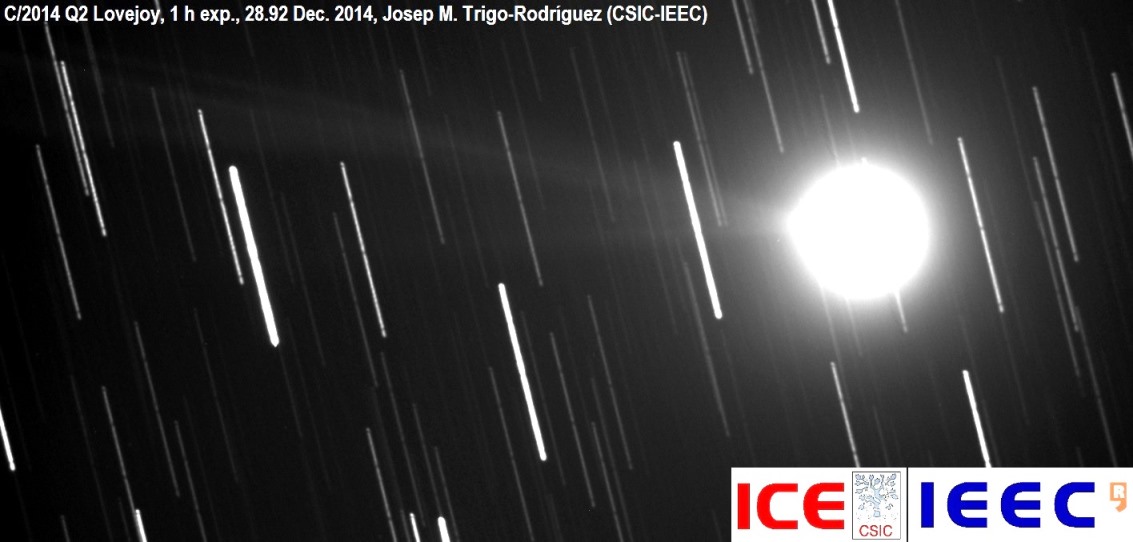
1 hour stacked CCD image of comet C/2014 Q2 (Lovejoy) taken by J.M. Trigo on Dec. 28.92, 2014 when this object was 135.4
million km from the Earth, and 91.8 million km from the Sun. Note the complex fan structure in the plasma tail and the bright coma.
Download here a *.wmv 30 min. movie
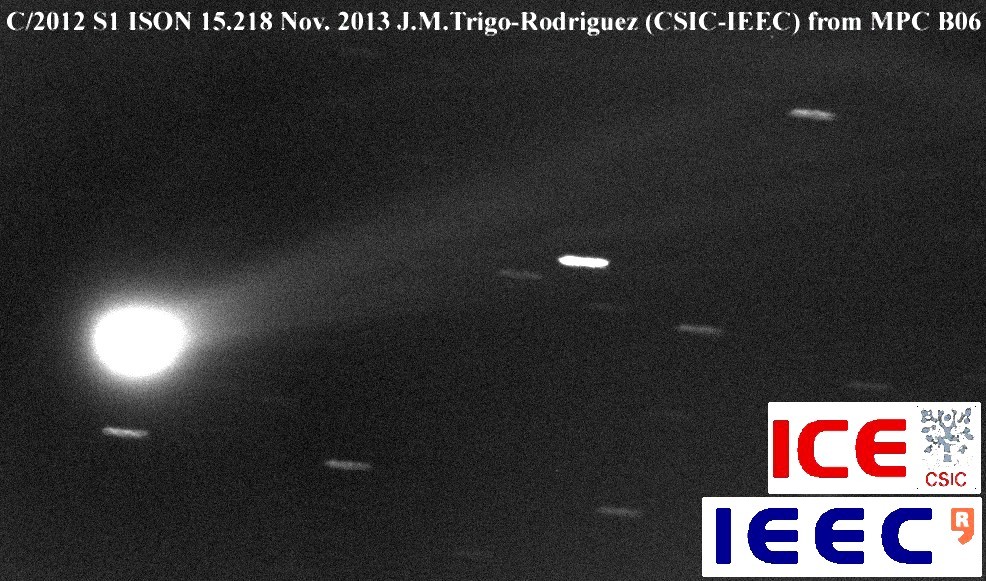
1 minute stacked CCD image of comet C/2012 S1 (ISON) taken by J.M. Trigo on Nov. 15.218, 2013 when this object was 78.8
million km from the Earth, and 206.1 million km from the Sun. Note the complex fan structure, and the bright coma
produced after the first noticed outburst On Nov. 14. The comet's dust tail is shown here on top while several plasma
tails (usually thin and straight) are noticeable just below.
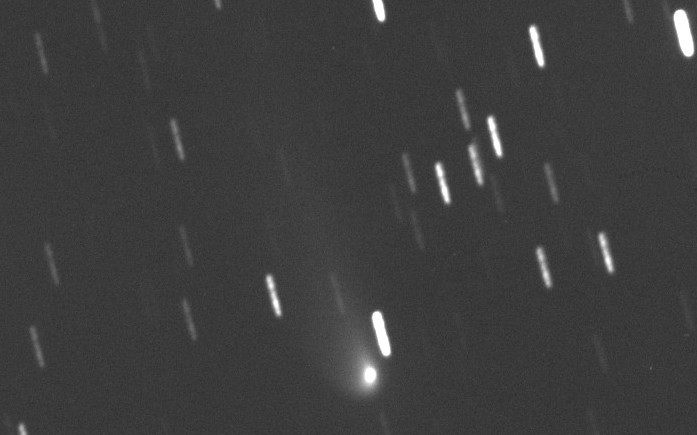
30 minutes stacked CCD image of comet 81P/Wild 2 obtained on Dec. 20, 2009 when this object was 205
million km away from the Earth. Note that this fascinating Kuiper Belt object suffered a close encounter with Jupiter
on Sep. 10, 1974 that modified its orbit. Due to this fortunate event, this pristine object was at the right distance to
be selected as target of opportunity by NASA to be visited by Stardust spacecraft. This NASA mission collected the
first materials from a solar system body different to the Moon. Dr. Trigo-Rodríguez formed part of the
Preliminary Examination Team of Stardust.
Additional details on Stardust (NASA) mission
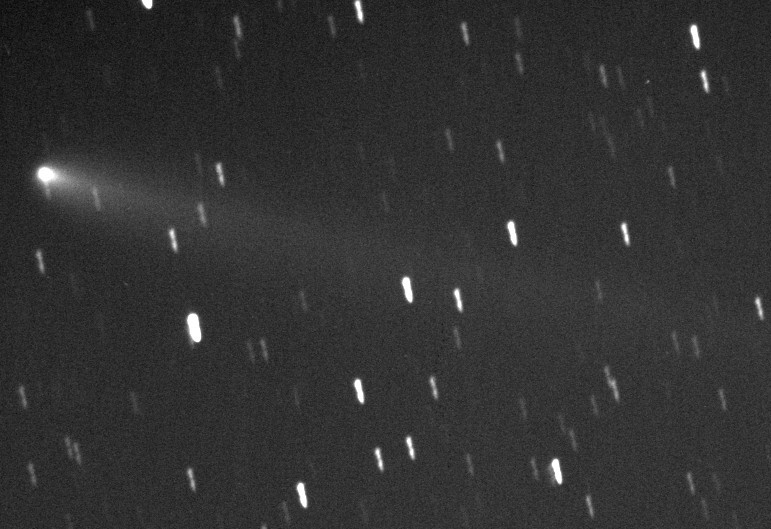
14 minutes stacked CCD image of comet P2009Q4 (Boattini) obtained on Feb. 21.95, 2010 when this object was 250
million km from the Earth. Note the comet's tail crossing all the telescope field.

5 minutes exposure photograph of comet C/1996 B2 (Hyakutake) obtained on Apr. 17, 1996 when this famous comet was about 113
million km away from the Earth, and 78 million km from the Sun. To take this picture a prime focus off-axis follow-up of
the comet nucleus was performed. Note that the yellow dust tail is produced by the scattering of solar light in tiny particles,
while the blue (filamentous) tail is mainly produced by ionized gas that is leaving the comet under the solar wind pressure.
A plasma tail is usually narrow with nods and twists and has a bluish appearance, just like the picture shows.
Additional Hyakutake pictures of the author reported
to the IAC (Hyakutake Photographic Competition)
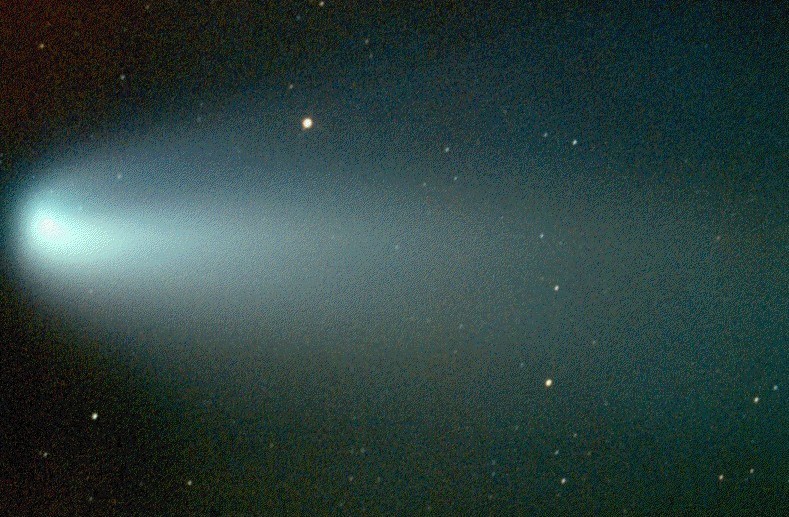
1.5 minutes exposure photograph of comet C/1995 O1 (Hale-Bopp) obtained on Mar. 8.18, 1997 when this fascinating comet was 209
million km away from the Earth. To take this picture a prime focus off-axis follow-up of the comet nucleus
was performed.
Additional Hale-Bopp pictures of the author reported
to JPL (NASA)
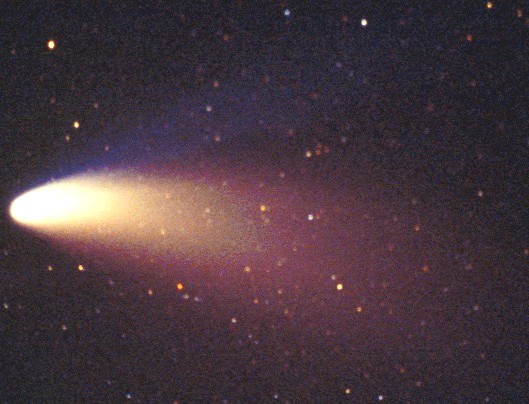
10 minutes exposure photograph of comet C/1995 O1 (Hale-Bopp) obtained on Abr. 2.9, 1997 when this fascinating comet was 203
million km away from the Earth, and 138 million km from the Sun. To take the picture the camera with a 210mm f:4 lens was
mounted in piggyback of the telescope.
Additional Hale-Bopp pictures of the author reported
to JPL (NASA)
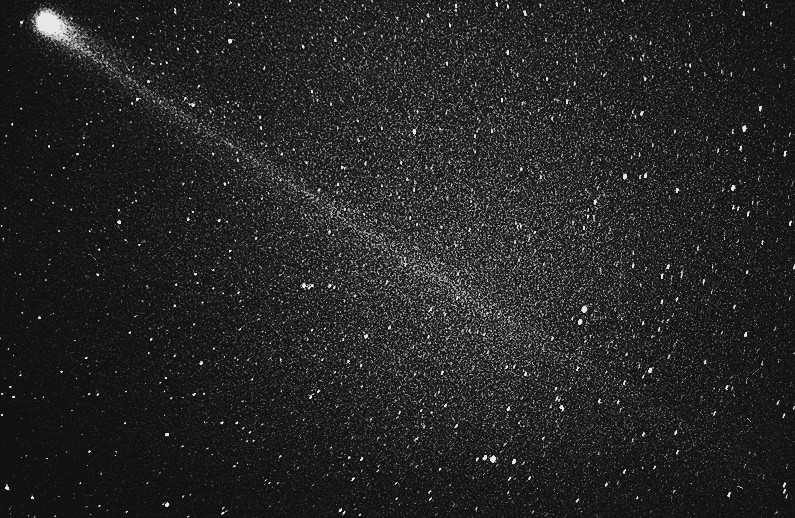
10 minutes exposure photograph of comet C/1996 B2 (Hyakutake) obtained by Dr. Trigo-Rodríguez on Mar. 27, 1996 when
this comet was only 17 million km away from the Earth, and 149 million km from the Sun. The original picture shows the ion tail
extended more than 70º (!). To take this picture the camera with a 80mm f:3.5 lens was mounted in piggyback of the
telescope. A Kodak 400 TMAX b&w film was used.
Additional Hyakutake pictures of the author reported
to the IAC (Hyakutake Photographic Competition)
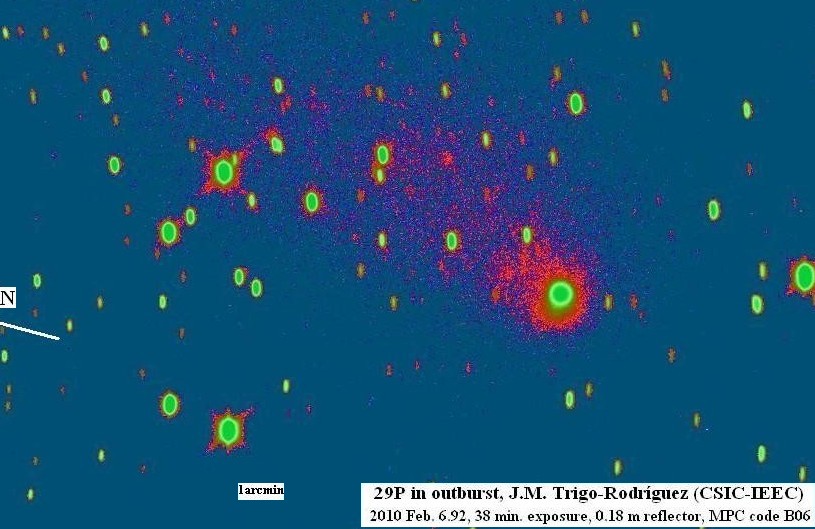
38 minutes stacked, false colour, CCD image of comet 29P/Schwassmann-Wachmann 1 obtained on Feb. 6.92, 2010 when this object was 780
million km away from the Earth. Despite of this large distance, the comet was in magnitude +12, easily reachable by using amateur
telescopes due to have experienced an outburst (massive release of dust from its surface). For long time this comet has been considered the archetype of comets exhibiting unusual changes in their coma appearance and brightness.
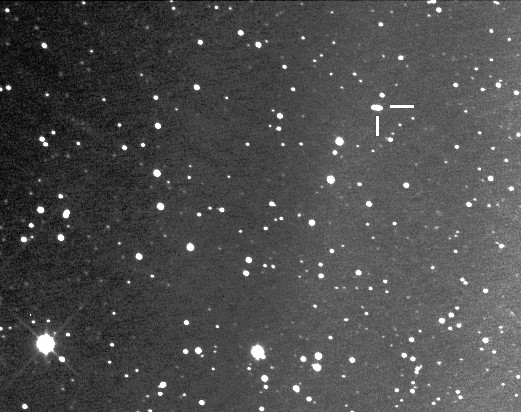
7.5 minutes stacked CCD image to show the apparent movement of asteroid 631 Philippina between the stars.
This image was obtained on Jul. 16.97, 2006 when this object was 318 million km away from the Earth. Note that
the object has been marked with two white lines to make easy its identification. This asteroid was discovered
from Heidelberg Observatory by A. Kopff on 1907.
DEEP SKY HIGHLIGHTS: GALAXIES, NEBULAE, STELLAR CLUSTERS...
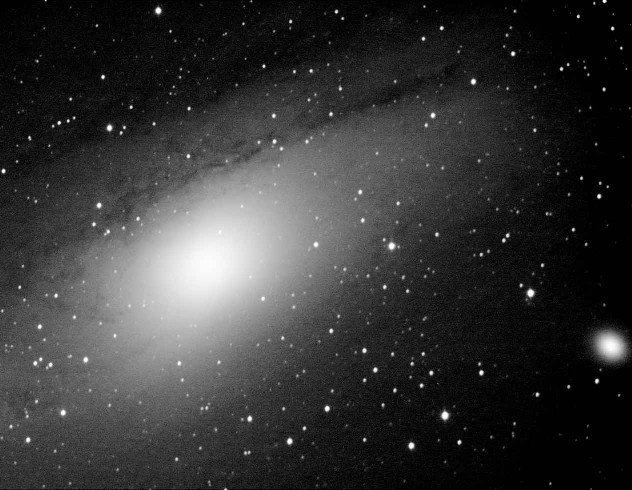
4 minutes stacked CCD image of the core of Andromeda galaxy (M31, catalogue Messier) also showing its dwarf satellite galaxy M32.
Our distance to this nearby galaxy is about 2.5 million light-years. This galaxy can be seen naked eye with small telescopes under extremely good
atmospheric conditions as a tenuous nebula. This galaxy is, in fact, the most distant object that can be seen with the naked eye, being superb in binoculars.
Additional details on M31
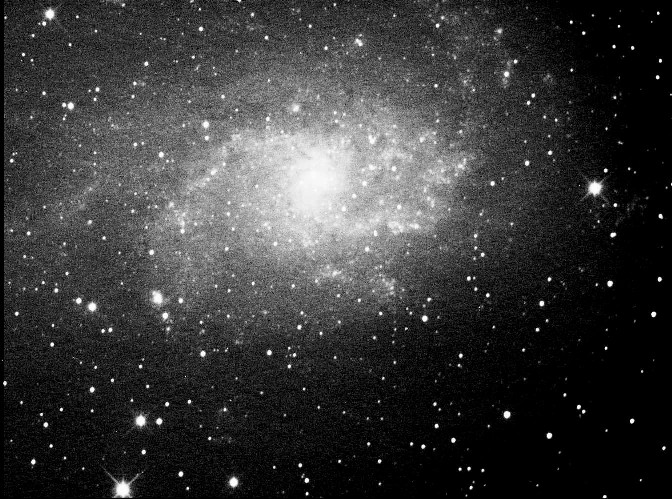
6.5 minutes stacked CCD image of the magnificent Triangle galaxy (M33). This image
was obtained on July 9.1, 2006. Note the clear visibility of the spiral arms.
According to the recent Hipparcos satellite the distance to M33 is about 3 million light-years. This galaxy can be seen with small telescopes under extremely
good atmospheric conditions as
a tenous nebula.
Additional details on M33
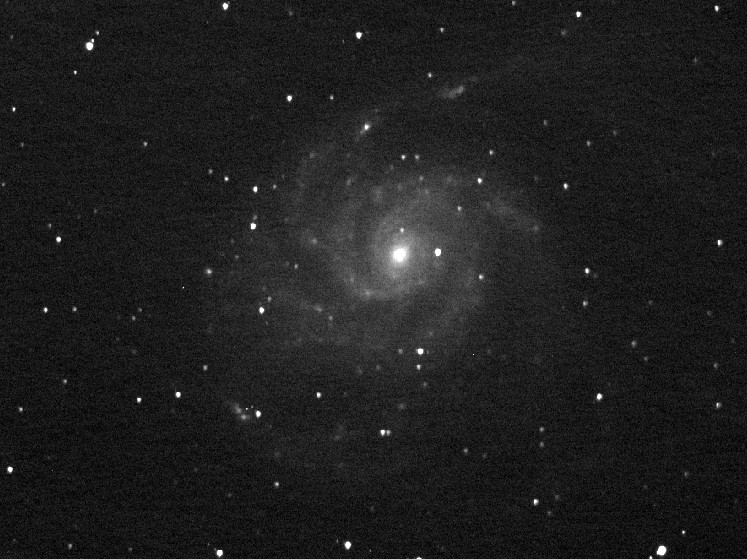
7.6 minutes stacked CCD image of the magnificent spiral galaxy (M101) located in Ursa Major constellation. This image
was obtained on July 16.9, 2006. Note the extended spiral arms of this wonderful galaxy. According to the Hubble Space Telescope
measurements M101 is about 24 million light-years from us. This galaxy can be seen with small telescopes from the countryside.
Additional details on M101
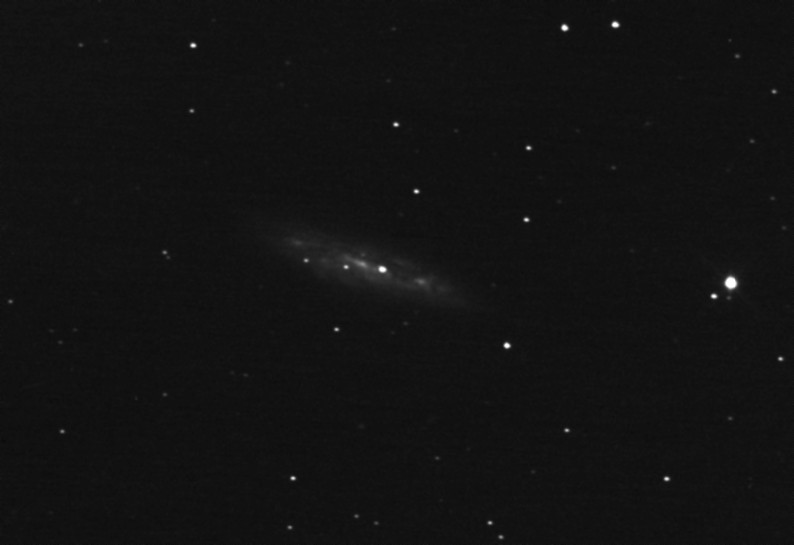
7 minutes stacked CCD image of the barred spiral galaxy (M108) located in in Ursa Major constellation. In this image
obtained on Feb. 27.04, 2008 is distinguishable its irregular structure without a clear nucleus, but with several arms.
Note that seen from the Earth this galaxy is almost in an edge-on geometric configuration. It was discovered as a faint
nebula by the famous French astronomer Pierre Méchain on 1781 nearby the star Beta Ursa Majoris. M108 is really far away,
just about 45,000 million light-years away from us. Additional details on M100
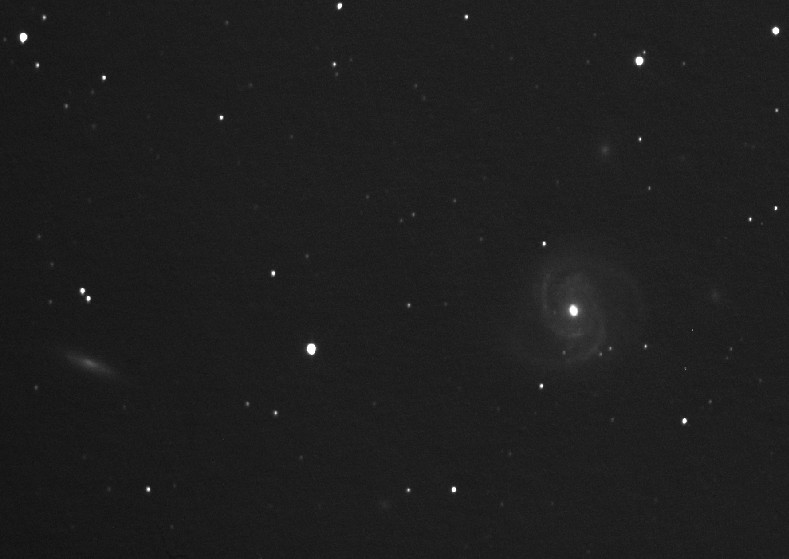
4.5 minutes stacked CCD image of the spiral galaxy (M100) located in the famous Virgo cluster. In this image
obtained on Feb. 21.1, 2010 is remarkable the abundance of galaxies in the field, but not surprising taking
into account that in that direction of space is the Coma-Virgo cluster of galaxies. According to recent Hubble Space
Telescope measurements M100 is about 56 million light-years away from us.
Additional details on M100
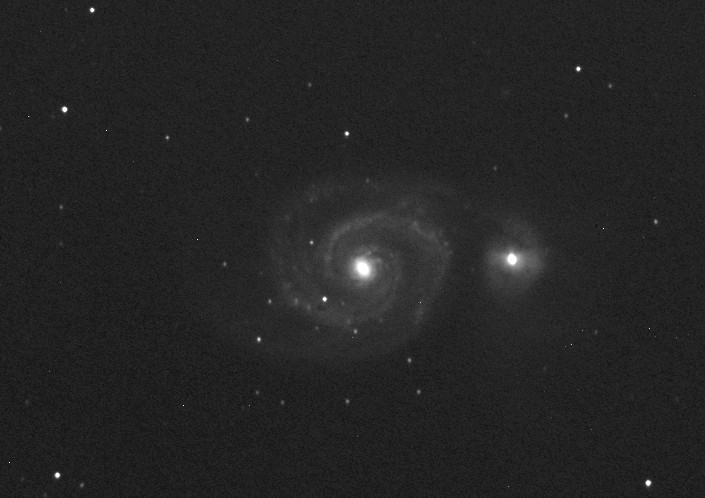
2 minutes stacked CCD image of the Whirlpool spiral galaxy (M51) located in the constellation of Canes Venatici.
In this image obtained on Jul. 20.95, 2006 is easily visible the connecting arm among M51 and its colliding companion
(M51b or NGC 5195) located on the left. In fact, the spiral structure of the Whirlpool galaxy was strongly affected by a
collision with that dwarf gallaxy. Gravity waves created in such an cosmic encounter have promoted massive stellar growth
in different regions, particularly in the arm connecting both galaxies.
Download the Hubble Heritage mosaic in poster (!)
Studies of M51 variable stars by using the Hubble Space Telescope have revealed that this galaxy is about
27 million light-years away from us.
Additional details on M51
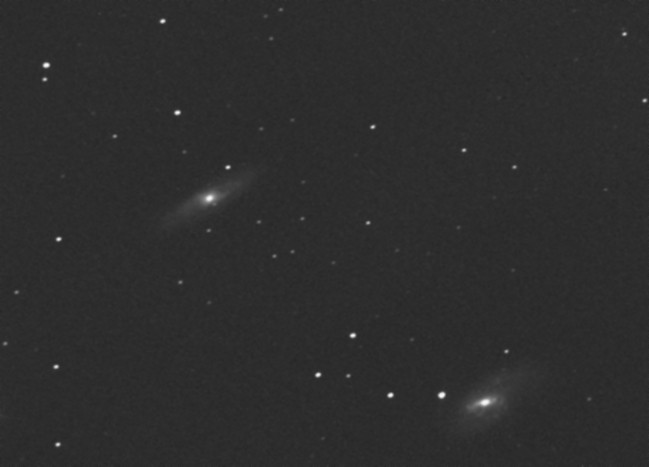
3 minutes stacked CCD image of the M65 and M66 galaxies located in Leo constellation. In this image
obtained on May 20.89, 2006 note that M65 appears close to the center of the image, and M66 is below.
This nice couple of spiral galaxies together with NGC 3628 form a small group of galaxies known as the Leo Triplet.
These galaxies are about 35 million light-years away from us. Additional details on M65 and M66
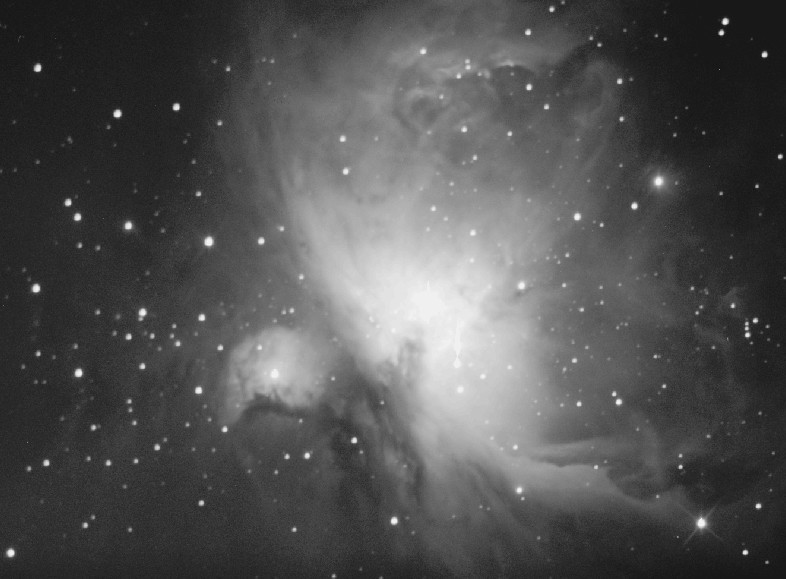
5 minutes stacked CCD image of the Orion nebula (M42) taken on Dec. 20.1, 2009. Our Milky Way galaxy is full of regions of
stellar formation, but by fortune we are close enough to this one (about 1,300 light-years) to be able to reveal with large telescopes
the formation of planetary systems in Orion nebula's interior.
Additional details on M42
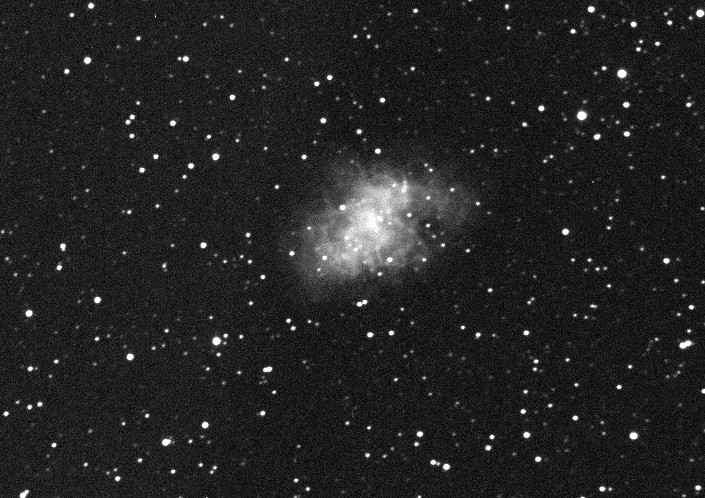
2 minutes stacked CCD image of the Crab nebula (first nebular object identified by Charles Messier in his catalogue: M1) taken on Oct. 14.04, 2007. This nebula was born from the hot expanding
cloud generated in the explosion of the bright Supernova observed by Chinese astronomers on 1054 AD. From their records of the exact
sky location where the star exploded, and its properties has been infered that the nebula was born at that time from the death of a massive star.
In this case the stellar nucleus survided to the massive stellar collapse, but the nebula is expanding outwards. Amazingly, nowadays sequenced images
taken by the Hubble Space Telescope (HST) have revealed the presence of a pulsar star in its interior.
Really, you must see NASA's movie!
Astronomers put this funny name to the nebula from its relative similitude with a crab. M1 forms part of our Milky way, and represents the late stadium
in the evolution of a star more massive than our Sun. The nebula expands enriching with the stellar-synthesized heavy elements
the surrounding interstellar medium. The distance to M57 is about 6,300 light-years.
More details on the Crab Nebula
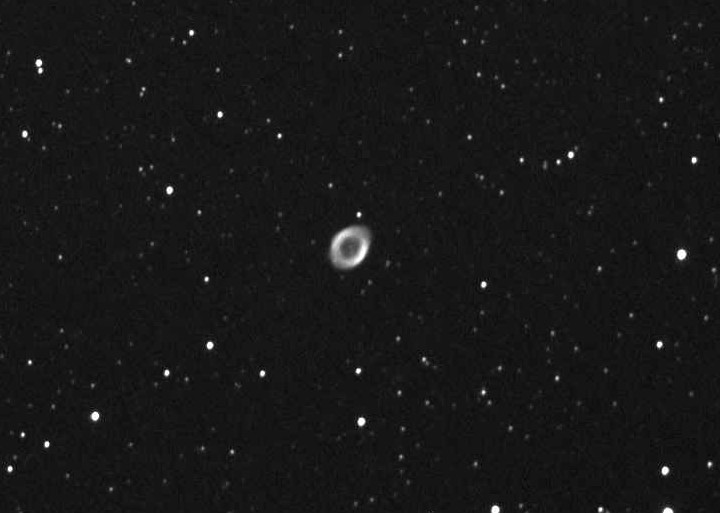
50 seconds stacked CCD image of the Ring "planetary" nebula (M57) taken on July 9, 2006. Note the central star that is the surviving core
of the star from which the nebula has originated. This nebula forms part of our Milky way, and represents the late stadium
in the evolution of a star like our own Sun.The distance to M57 is about 3,000 light-years.
More details on M57
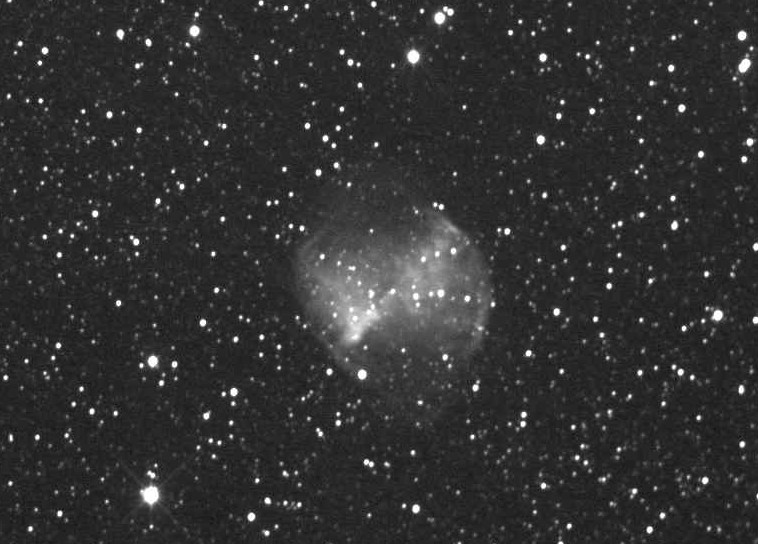
6 minutes stacked CCD image of the Dumbbell "planetary" nebula (M27) taken on July 9.05, 2006. Note that this nebula
forms part of our Milky way, and like M57 represents the late stadium in the evolution of a star like our own Sun.
The distance to M27 is about 1,250 light-years.
More details on M27
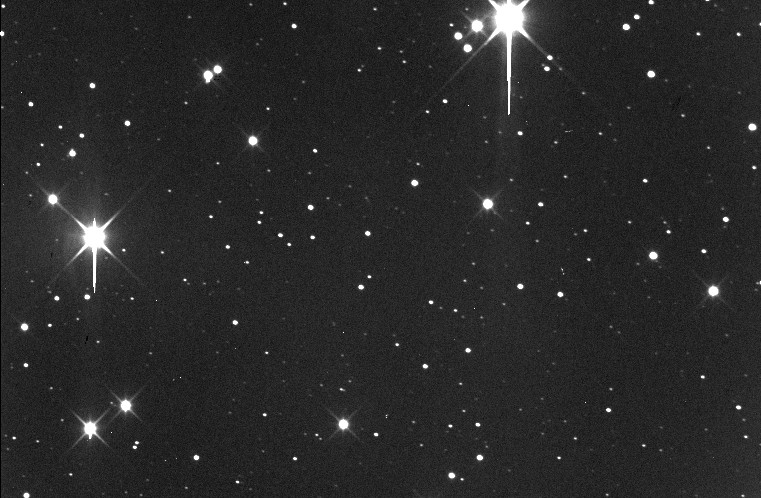
1.5 minutes stacked CCD image of the inner region of the Pleiades (M45) open cluster taken on Jul. 29.13, 2006.
This beautiful cluster is visible at naked eye in Perseus constellation, being only 440 light-years away from us.
It is formed by really young stars that are still keeping part of the gas nebula from which
they were born. This "gaseous cloud" is giving a blurry appearance, like a candle seen between
fog, of some of the stars located on the left side.
Additional details on the Pleiades cluster
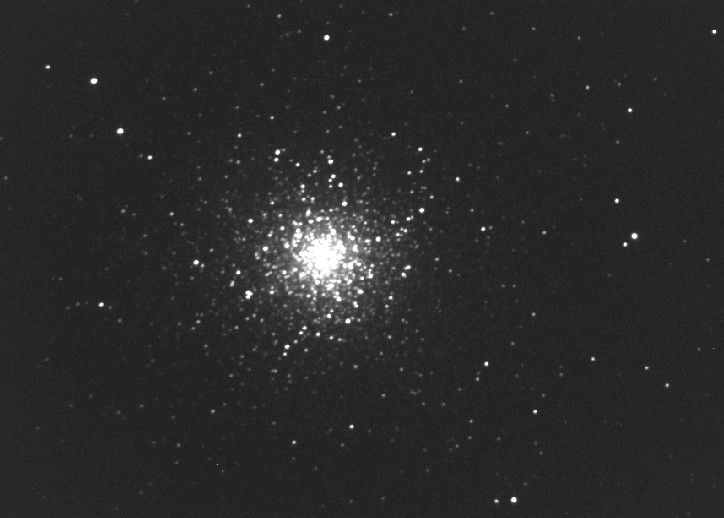
4 minutes stacked CCD image of the magnificent Hercules globular cluster (M13) as taken on Apr. 27.06, 2008.
This globular cluster covers 20 arcminutes (1/3 of a degree) and is easily visible through binoculars as a
concentrated fuzzy patch, and even to the naked eye can be identified under
dark sky conditions. Located in Hercules constellation, is about 25,100 light-years away from us.
Additional details on the Hercules globular cluster
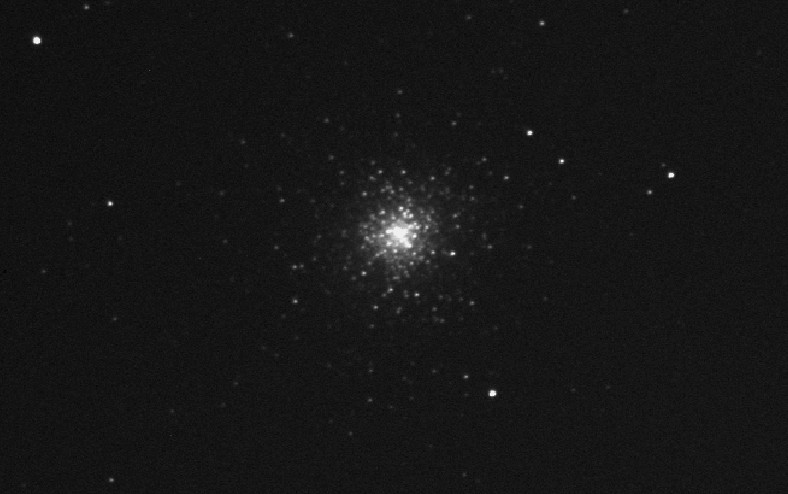
20 seconds stacked CCD image of M2 globular cluster taken on Jul. 16.96, 2006. This nice cluster is
located in Aquarius constellation, being about 37,500 light-years away from us.
Additional details on M2 globular cluster
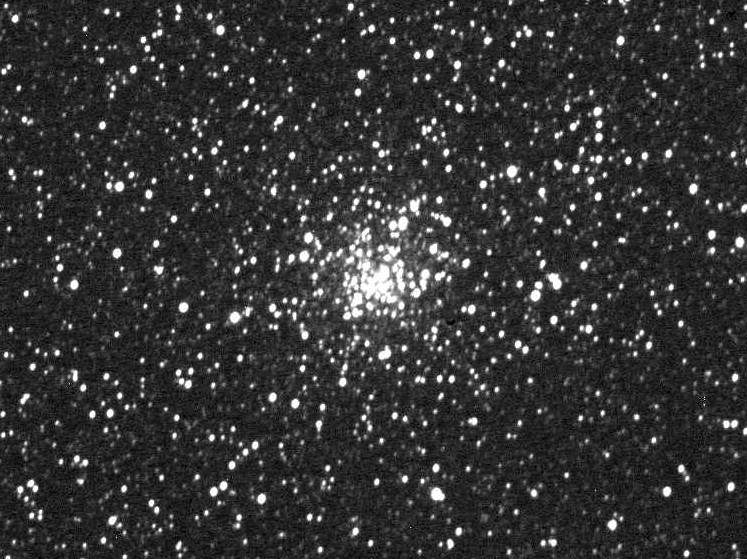
1 minute stacked CCD image of M71 globular cluster taken on Jul. 9.03, 2006. This nice cluster is located
in direction to the Milky Way galactic nucleus (Sagitta constellation) so the background is covered by many stars
that are in our way to M71. This impressive globular cluster is about 13,000 light-years away from us, a kind of
globular island of stars orbiting the Milky Way.
More details on M71
Tell me which are your favourite pictures:Ph.D. Josep M. Trigo-Rodríguez (CSIC-IEEC).
| |

































